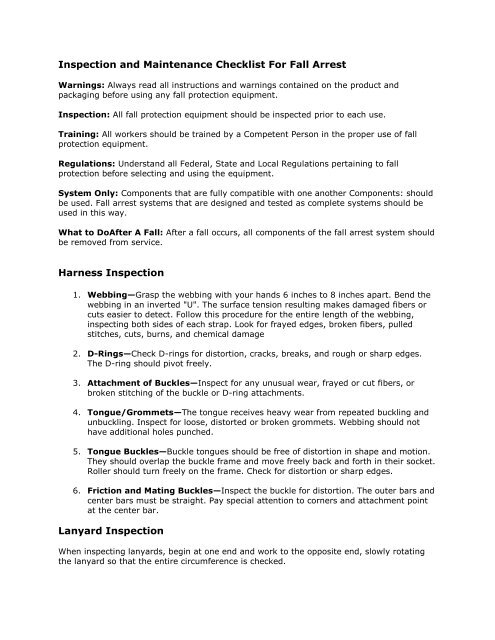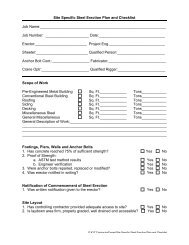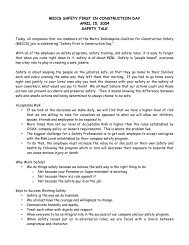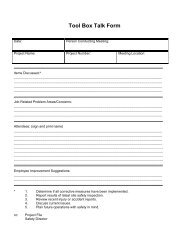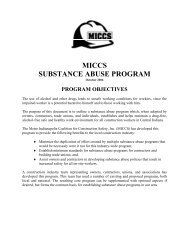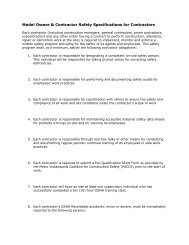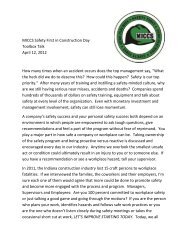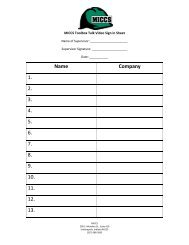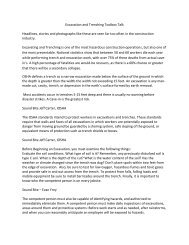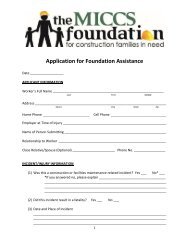Inspection and Maintenance Checklist For Fall Arrest ... - miccs
Inspection and Maintenance Checklist For Fall Arrest ... - miccs
Inspection and Maintenance Checklist For Fall Arrest ... - miccs
- No tags were found...
You also want an ePaper? Increase the reach of your titles
YUMPU automatically turns print PDFs into web optimized ePapers that Google loves.
<strong>Inspection</strong> <strong>and</strong> <strong>Maintenance</strong> <strong>Checklist</strong> <strong>For</strong> <strong>Fall</strong> <strong>Arrest</strong>Warnings: Always read all instructions <strong>and</strong> warnings contained on the product <strong>and</strong>packaging before using any fall protection equipment.<strong>Inspection</strong>: All fall protection equipment should be inspected prior to each use.Training: All workers should be trained by a Competent Person in the proper use of fallprotection equipment.Regulations: Underst<strong>and</strong> all Federal, State <strong>and</strong> Local Regulations pertaining to fallprotection before selecting <strong>and</strong> using the equipment.System Only: Components that are fully compatible with one another Components: shouldbe used. <strong>Fall</strong> arrest systems that are designed <strong>and</strong> tested as complete systems should beused in this way.What to DoAfter A <strong>Fall</strong>: After a fall occurs, all components of the fall arrest system shouldbe removed from service.Harness <strong>Inspection</strong>1. Webbing—Grasp the webbing with your h<strong>and</strong>s 6 inches to 8 inches apart. Bend thewebbing in an inverted "U". The surface tension resulting makes damaged fibers orcuts easier to detect. Follow this procedure for the entire length of the webbing,inspecting both sides of each strap. Look for frayed edges, broken fibers, pulledstitches, cuts, burns, <strong>and</strong> chemical damage2. D-Rings—Check D-rings for distortion, cracks, breaks, <strong>and</strong> rough or sharp edges.The D-ring should pivot freely.3. Attachment of Buckles—Inspect for any unusual wear, frayed or cut fibers, orbroken stitching of the buckle or D-ring attachments.4. Tongue/Grommets—The tongue receives heavy wear from repeated buckling <strong>and</strong>unbuckling. Inspect for loose, distorted or broken grommets. Webbing should nothave additional holes punched.5. Tongue Buckles—Buckle tongues should be free of distortion in shape <strong>and</strong> motion.They should overlap the buckle frame <strong>and</strong> move freely back <strong>and</strong> forth in their socket.Roller should turn freely on the frame. Check for distortion or sharp edges.6. Friction <strong>and</strong> Mating Buckles—Inspect the buckle for distortion. The outer bars <strong>and</strong>center bars must be straight. Pay special attention to corners <strong>and</strong> attachment pointat the center bar.Lanyard <strong>Inspection</strong>When inspecting lanyards, begin at one end <strong>and</strong> work to the opposite end, slowly rotatingthe lanyard so that the entire circumference is checked.
1. Hardware—a. Snaps: Inspect closely for hook <strong>and</strong> eye distortions, cracks, corrosion, orpitted surfaces. The keeper (latch) should seat into the nose without binding<strong>and</strong> should not be distorted or obstructed. The keeper spring should exertsufficient force to firmly close the keeper. Keeper locks must prevent thekeeper from opening when the keeper closes.b. Thimbles: The thimble must be firmly seated in the eye of the splice, <strong>and</strong> thesplice should have no loose or cut str<strong>and</strong>s. The edges of the thimble must befree of sharp edges, distortion, or cracks.2. Steel Lanyard—While rotating the steel lanyard, watch for cuts, frayed areas, orunusual wearing patterns on the wire. Broken str<strong>and</strong>s will separate from the body ofthe lanyard.3. Web Lanyard—While bending webbing over a pipe, observe each side of thewebbed lanyard. This will reveal any cuts or breaks. Swelling, discoloration, cracks<strong>and</strong> charring are obvious signs of chemical or heat damage. Observe closely for anybreaks in stitching.4. Rope Lanyard—Rotation of the rope lanyard while inspecting from end-to-end forany fuzzy, worn, broken or cut fibers. Weakened areas from extreme loads willappear as a noticeable change in original diameter. The rope diameter should beuniform throughout, following a short break-in period.5. Shock Absorber Pack—The outer portion of the pack should be examined for burnholes <strong>and</strong> tears. Stitching on areas where the pack is sewn to D-rings. Belts, orlanyards should be examined for loose str<strong>and</strong>s, rips, <strong>and</strong> deterioration.6. Shock-Absorbing Lanyard—Shock-absorbing lanyards should be examined as aweb lanyard (described in Item 3 above). However, also look for the warning flag orsigns of deployment. If the flag has been activated, remove this shock-absorbinglanyard from service.CleaningBasic care of all safety equipment will prolong the durable life of the unit <strong>and</strong> will contributetoward the performance of its vital safety function. Proper storage <strong>and</strong> maintenance afteruse are as important as cleaning the equipment of dirt, corrosives, or contaminants.Storage areas should be clean, dry <strong>and</strong> free of exposure to fumes or corrosive elements.Nylon or Polyester—Remove all surface dirt with a sponge dampened in plain water.Squeeze the sponge dry. Dip the sponge in a mild solution of water <strong>and</strong> commercial soap ordetergent. Work up a lather with a vigorous back <strong>and</strong> forth motion; then wipe with a cleancloth. Hang freely to dry, but away from excessive heat.Drying—Equipment should dry thoroughly without close exposure to heat, steam, or longperiods of sunlight.


